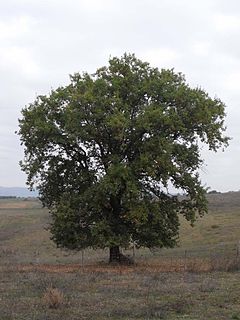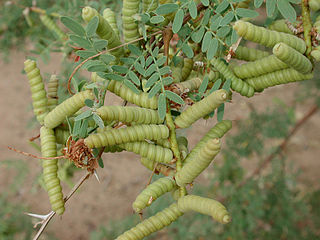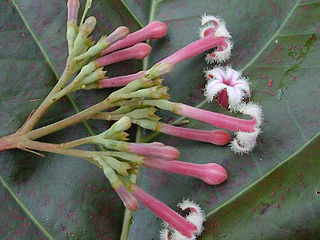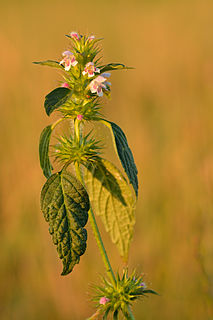
Betula pubescens, commonly known as downy birch and also as moor birch, white birch, European white birch or hairy birch, is a species of deciduous tree, native and abundant throughout northern Europe and northern Asia, growing farther north than any other broadleaf tree. It is closely related to, and often confused with, the silver birch, but grows in wetter places with heavier soils and poorer drainage; smaller trees can also be confused with the dwarf birch.

Capsicum pubescens is native to Bolivia, Peru and Ecuador and dates back to pre-Incan times; traces of its presence have been found in the Guitarrero Caves. The existence of Capsicum pubescens was documented by ancient Peruvians of the Paracas, Nazca, Moche, and Chimu cultures, through textiles, ceramics, and domestic remains. This chili pepper is the most important ingredient of the Bolivian sauce llajwa. It is also considered the flagship of Peru and it is consumed fresh, paste, dried, or ground. It belongs to a species of the genus Capsicum (pepper), and is known in Peru and Ecuador as rocoto, locoto in Bolivia and Argentina and as the manzano pepper in Mexico which means 'apple' for its apple-shaped fruit. This species is found primarily in Central and South America, and is known only in cultivation. The species name, pubescens, means hairy, which refers to the hairy leaves of this pepper. The hairiness of the leaves, along with the black seeds, distinguish this species from others. As they reach a relatively advanced age and the roots lignify quickly, sometimes they are called tree chili. Of all the domesticated species of peppers, this is the least widespread and systematically furthest away from all others. It is reproductively isolated from other species of the genus Capsicum. A very notable feature of this species is its ability to withstand cooler temperatures than other cultivated pepper plants, although it cannot withstand frost.

Quercus pubescens, the downy oak or pubescent oak, is a species of white oak native to southern Europe and southwest Asia, from northern Spain (Pyrenees) east to the Crimea and the Caucasus. It is also found in France and parts of central Europe.

Prosopis pubescens, commonly known as screwbean mesquite, is a species of flowering shrub or small tree in the pea family, Fabaceae, that is native to the southwestern United States and northern Mexico.

Cinchona pubescens, also known as red cinchona and quina (Quechua), is native to Central and South America. It is known as a medicinal plant for its bark's high quinine content- and has similar uses to Cinchona officinalis in the production of quinine, most famously used for treatment of malaria.
Xanthophyllum bullatum is a species of plant in the family Polygalaceae. It is a tree endemic to Peninsular Malaysia. It is threatened by habitat loss.

Xanthophyllum is a genus of about 109 species of trees and shrubs, of the plant family Polygalaceae;. The generic name is from the Greek meaning "yellow leaf", referring to how the leaves are often yellow when dry. In Borneo it is known as minyak berok in Malay or nyalin in the Iban language.
Xanthophyllum monticolum is a species of plant in the family Polygalaceae. It is a tree endemic to Peninsular Malaysia. It is threatened by habitat loss.
Xanthophyllum sulphureum is a species of plant in the family Polygalaceae. It is a tree endemic to Peninsular Malaysia. It is threatened by habitat loss.
As of July 2016, the International Union for Conservation of Nature (IUCN) lists 238 conservation dependent species. 0.29% of all evaluated species are listed as conservation dependent. The IUCN also lists seven subspecies and five varieties as conservation dependent.

Lactarius pubescens, commonly known as the downy milk cap, is a species of fungus in the family Russulaceae. It is a medium to large agaric with a creamy-buff, hairy cap, whitish gills and short stout stem. The fungus has a cosmopolitan distribution, and grows solitarily or in scattered groups on sandy soil under or near birch.

Galeopsis, commonly called hemp-nettle or hempnettle, is a genus of annual herbaceous plants native to Europe and Asia. Some species are naturalized in North America and New Zealand.
Xanthophyllum ceraceifolium is a tree in the family Polygalaceae. The specific epithet ceraceifolium means "waxy leaf", referring to the appearance of the leaves.
Xanthophyllum korthalsianum is a tree in the family Polygalaceae. It is named for the Dutch botanist Pieter Willem Korthals.
Xanthophyllum neglectum is a tree in the family Polygalaceae. The specific epithet neglectum is from the Latin meaning "neglected", referring to how the species has been long overlooked.
Hypericum pubescens is a perennial herb in the Hypericaceae family. It is in the section Adenosepalum.

Wrightia pubescens is a species of small tree in the family Apocynaceae. Its distribution includes: Australia, southern China, Taiwan (introduced), Indonesia, New Guinea, Philippines and Indo-China. In Viet Nam, it may be called: lòng mức lông.

Hypericum sect. Adenosepalum is one of 36 sections in the genus Hypericum. Its type species is Hypericum montanum.

Xanthophyllum lanceatum is a tree in the Polygalaceae family. It grows across Southeast Asia from Sumatera to Bangladesh. The leaves are used as a hops-substitute in beer making and the wood as fuel. Fish in the Mekong regularly eat the fruit, flowers and leaves.











